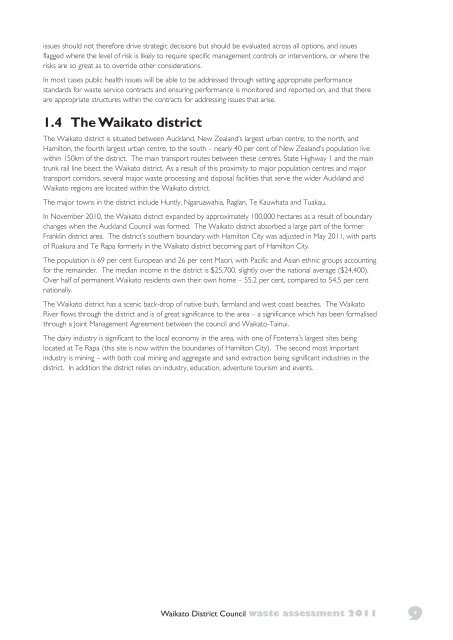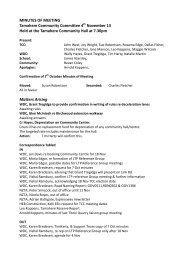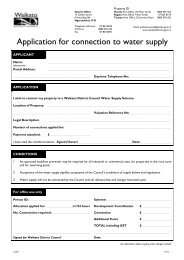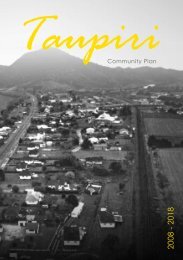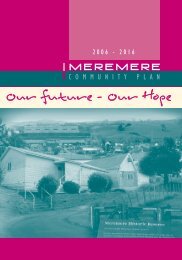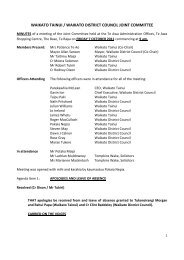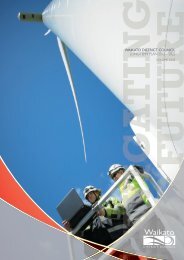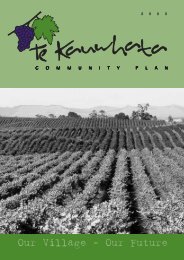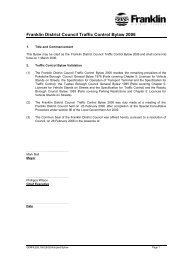and <strong>of</strong>fensive trades (Third Schedule). The Health Act enables TAs to raise loans for certain sanitary works and/or to receive government grants and subsidies, where available. 31.3.5 The Hazardous Substances and New Organisms Act 1996(the HSNO Act)The HSNO Act addresses the management <strong>of</strong> substances (including their disposal) that pose a significant risk tothe environment and/or human health. The Act relates to <strong>waste</strong> management primarily through controls on theimport or manufacture <strong>of</strong> new hazardous materials and the handling and disposal <strong>of</strong> hazardous substances.Depending on the amount <strong>of</strong> a hazardous substance on site, the HSNO Act sets out requirements for materialstorage, staff training and certification. These requirements would need to be addressed within operational andhealth and safety plans for <strong>waste</strong> facilities. Hazardous substances commonly managed by TAs include used oil,household chemicals, asbestos, agrichemicals, LPG and batteries.The HSNO Act provides minimum national standards that may apply to the disposal <strong>of</strong> a hazardous substance.However, under the RMA a regional council or TA may set more stringent controls relating to the use <strong>of</strong> landfor storing, using, disposing <strong>of</strong> or transporting hazardous substances. 41.3.6 Resource Management Act (1991) (RMA)Although the RMA focuses on the environmental effects <strong>of</strong> activities, in practice there is a significant crossoverbetween environmental impacts and human health impacts. Therefore many <strong>waste</strong> management activities thatare likely to have public health impacts are controlled through the RMA. This may include site discharges suchas odour, groundwater contamination, particulates and other aerosols, presence <strong>of</strong> vermin etc.1.3.7 Key <strong>waste</strong> management public health issuesKey issues that are likely to be <strong>of</strong> concern in terms <strong>of</strong> public health include the following:• Management <strong>of</strong> putrescible <strong>waste</strong>s• Management <strong>of</strong> nappy and sanitary <strong>waste</strong>s Management <strong>of</strong> putrescible <strong>waste</strong>s• Management <strong>of</strong> nappy and sanitary <strong>waste</strong>s• Potential for dog/seagull/ vermin strike• Timely collection <strong>of</strong> material• Management <strong>of</strong> spillage• Litter and illegal dumping• Medical <strong>waste</strong> from households and healthcare operators• Storage <strong>of</strong> <strong>waste</strong>s• Management <strong>of</strong> hazardous <strong>waste</strong>s• Private on-site management <strong>of</strong> <strong>waste</strong>s (burning, burying, rural <strong>waste</strong> management etc).1.3.8 Management <strong>of</strong> public health issuesBroadly speaking, <strong>waste</strong> management related public health issues are likely to relate more to how specificprocesses are managed than to processes themselves. From a strategic perspective the above issues are likelyto apply to a greater or lesser extent to virtually all options under consideration. For example illegal dumpingtends to take place ubiquitously, irrespective <strong>of</strong> whatever <strong>waste</strong> collection and transfer station systems are inplace. Some systems may exacerbate the problem (infrequent collection, user charges, inconveniently locatedfacilities etc.), but by the same token the issues can be managed through methods such as enforcement,education, providing convenient facilities etc.In considering how public health issues should be addressed in the context <strong>of</strong> <strong>this</strong> <strong>waste</strong> <strong>assessment</strong> the viewis taken that public health issues are likely to present at least some level <strong>of</strong> risk across all options. Public health3 From: MfE 2009: Waste Management and Minimisation Planning, Guidance for Territorial Authorities.4 From: MfE 2009: Waste Management and Minimisation Planning, Guidance for Territorial Authorities.8
issues should not therefore drive strategic decisions but should be evaluated across all options, and issuesflagged where the level <strong>of</strong> risk is likely to require specific management controls or interventions, or where therisks are so great as to override other considerations.In most cases public health issues will be able to be addressed through setting appropriate performancestandards for <strong>waste</strong> service contracts and ensuring performance is monitored and reported on, and that thereare appropriate structures within the contracts for addressing issues that arise.1.4 The <strong>Waikato</strong> districtThe <strong>Waikato</strong> district is situated between Auckland, New Zealand’s largest urban centre, to the north, andHamilton, the fourth largest urban centre, to the south – nearly 40 per cent <strong>of</strong> New Zealand’s population livewithin 150km <strong>of</strong> the district. The main transport routes between these centres, State Highway 1 and the maintrunk rail line bisect the <strong>Waikato</strong> district. As a result <strong>of</strong> <strong>this</strong> proximity to major population centres and majortransport corridors, several major <strong>waste</strong> processing and disposal facilities that serve the wider Auckland and<strong>Waikato</strong> regions are located within the <strong>Waikato</strong> district.The major towns in the district include Huntly, Ngaruawahia, Raglan, Te Kauwhata and Tuakau.In November 2010, the <strong>Waikato</strong> district expanded by approximately 100,000 hectares as a result <strong>of</strong> boundarychanges when the Auckland <strong>Council</strong> was formed. The <strong>Waikato</strong> district absorbed a large part <strong>of</strong> the formerFranklin district area. The district’s southern boundary with Hamilton City was adjusted in May 2011, with parts<strong>of</strong> Ruakura and Te Rapa formerly in the <strong>Waikato</strong> district becoming part <strong>of</strong> Hamilton City.The population is 69 per cent European and 26 per cent Maori, with Pacific and Asian ethnic groups accountingfor the remainder. The median income in the district is $25,700, slightly over the national average ($24,400).Over half <strong>of</strong> permanent <strong>Waikato</strong> residents own their own home – 55.2 per cent, compared to 54.5 per centnationally.The <strong>Waikato</strong> district has a scenic back-drop <strong>of</strong> native bush, farmland and west coast beaches. The <strong>Waikato</strong>River flows through the district and is <strong>of</strong> great significance to the area – a significance which has been formalisedthrough a Joint Management Agreement between the council and <strong>Waikato</strong>-Tainui.The dairy industry is significant to the local economy in the area, with one <strong>of</strong> Fonterra’s largest sites beinglocated at Te Rapa (<strong>this</strong> site is now within the boundaries <strong>of</strong> Hamilton City). The second most importantindustry is mining – with both coal mining and aggregate and sand extraction being significant industries in thedistrict. In addition the district relies on industry, education, adventure tourism and events.<strong>Waikato</strong> <strong>District</strong> <strong>Council</strong> <strong>waste</strong> <strong>assessment</strong> 20119


